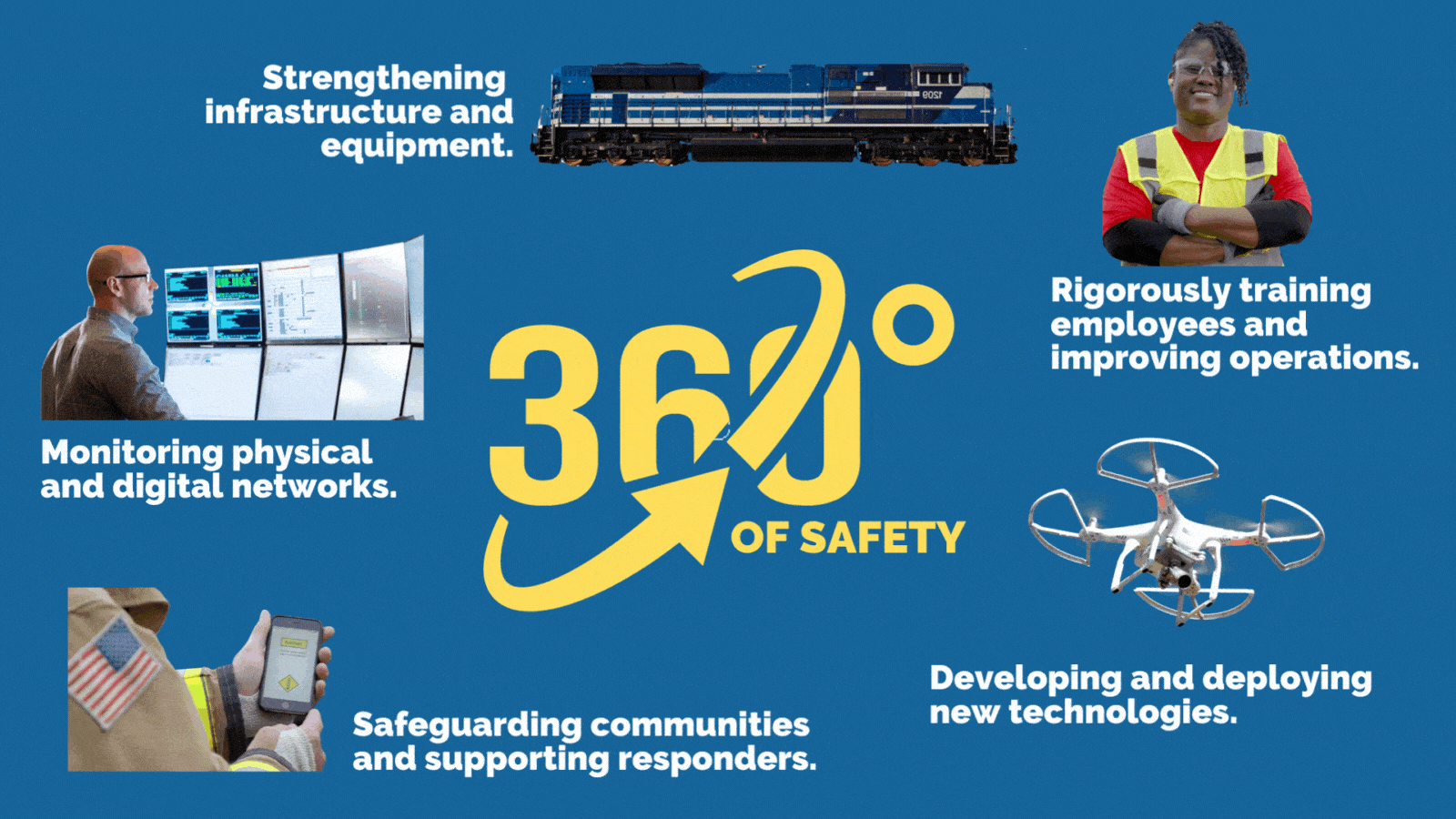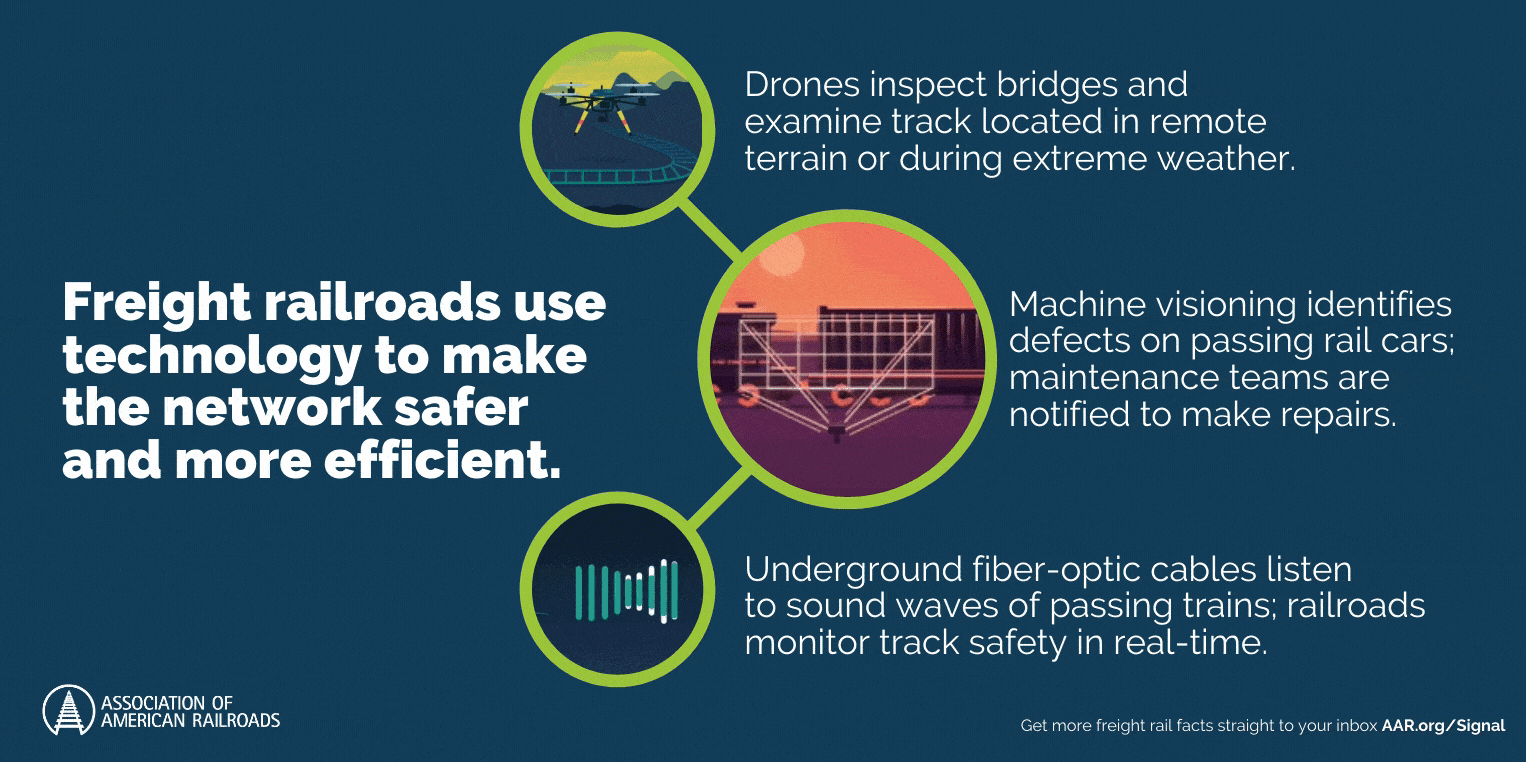Freight railroads have invested well over $23 billion a year over the past five years back into their networks, people and technology. Those investments have fueled recent safety gains, including the last decade being the safest ever for railroads and the employee injury rate being at an all-time low.
While efforts to date have produced a strong safety record, railroads continue to work with their employees, suppliers, customers and with officials at the FRA and across the government to assess and implement new approaches to continually improve rail safety.

Maintaining a State of Good Repair
Railroads are dedicated to meeting the high safety standards applied to every aspect of operations. Across the network, railroads employ thousands of well-trained inspectors — qualified per Federal Railroad Administration (FRA) regulations — who monitor and assess the health and safety of rail equipment, often exceeding the federal inspection regulations.
Since 2000, America’s Class I railroads have spent $439 billion on network maintenance and capital expenditures, while the train accident rate has decreased 27% since 2000. These investments have also led to the American Society of Civil Engineers considering rail to be the best infrastructure in America.
A Culture of Safety
The strong culture of safety that defines the railroad industry is a direct result of the emphasis railroads place on training and operational improvement. Daily safety briefings, peer-to-peer safety programs and state-of-the-art technical training centers, which feature simulators and virtual reality, are just some of the ways railroads empower their employees to put safety first.
Railroads and their partners also focus extensive resources on operational adjustments to make the network even safer. Software designed by the industry to identify the safest and most secure routes for moving hazmat and crude oil, known as the Rail Corridor Risk Management System, and enhanced safety features for hazmat rail cars are just a couple of examples of freight rail’s emphasis on operational safety. These efforts help make rail the safest way to ship hazmat. More than 99.99% of all hazmat moved by rail reaches its destination without a release caused by a train accident, and the hazmat accident rate is down 75% since 2000.
A Smarter, Safer Rail Network
Today’s advanced rail tech allows rail employees to inspect track and equipment with greater frequency, efficiency and reliability. These advanced tools also empower employees to make better decisions, arming them with data on the health of rail infrastructure and equipment that goes well beyond what the human eye can see.
The technologies used by rail inspectors include drones to inspect inaccessible areas and bridges; ultrasound technology to identify flaws within track; and specialized sensors mounted along track which identify faulty or worn rail car components as trains pass. Because the nation’s rail network is highly integrated, with equipment often operating across the networks of multiple rail companies, today’s technology allows employees to gather and share data so potential problems with equipment can be identified and addressed quickly.

Technology also has the potential to make meaningful progress toward the industry’s goal of eliminating highway-rail grade crossing accidents. As autonomous vehicle technology continues to be developed, railroads have called on the U.S. Department of Transportation (DOT) to ensure that these cars recognize and react properly to warning devices at grade crossings. This effort supplements the industry’s longstanding commitment to community education and highway-rail grade separation initiatives.
Engaging Communities
Freight trains are an ever-present aspect of life in thousands of cities and towns throughout the nation, making community engagement and partnerships a critical component of railroad safety efforts. And with more than 200,000 highway-rail grade crossings across the network, freight trains and the motoring public are often in contact.
To minimize the impact of these interactions, railroads work with their operations teams, local road authorities, private property owners and the DOT to identify crossings that can be upgraded or closed where feasible. Unfortunately, railroad operations can result in blocked crossings. Railroads have partnered with technology companies on mobile solutions and digital signage to provide alternative routing suggestions and estimated wait times.
Railroads also support Operation Lifesaver Inc. (OLI), a nonprofit public safety education and awareness organization dedicated to improving safety around rail tracks and crossings. OLI reaches millions of people each year through safety presentations, training sessions, social media and special events held nationwide, including Rail Safety Week, which happens each September.
Supporting First Responders
Each year, railroads train thousands of emergency first responders on how to safely respond to a rail incident at the world-class Security and Emergency Response Training Center (SERTC). Since its inception in 1985, SERTC has trained more than 70,000 students worldwide.
The industry developed the AskRail app to provide first responders the information they need to safely respond to a hazmat incident. Furthermore, all major railroads have teams devoted to emergency response that are on call 24/7 to provide local officials with access to information and other resources — from clothing for displaced families to environmental consultants.
Monitoring & Protecting The Network
The freight rail network is nearly 140,000 miles long and traverses throughout 49 states and the District of Columbia. Not seen is the complex digital infrastructure that helps power that physical network. Freight and passenger railroads work daily with government agencies and security, law enforcement and intelligence professionals to monitor and protect physical assets and cybersecurity. And since nature can pose a risk to outdoor operations, railroads also collaboratively prepare for and respond to weather threats to minimize network impact, swiftly restore service for customers and help communities rebuild.
